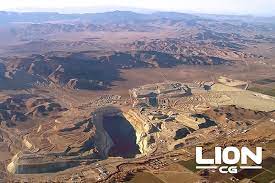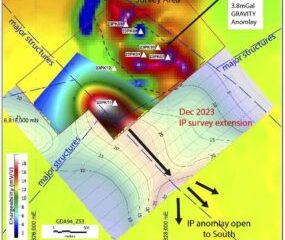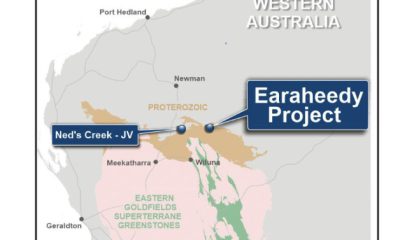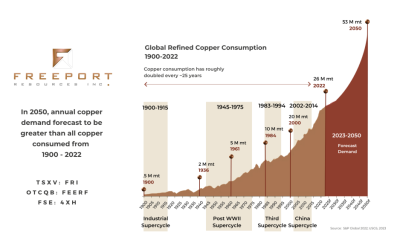Uncategorized
Lion Copper and gold drills 0.31% copper over 926 feet at Bear deposit, Nevada
Lion Copper and Gold Corp. [TSXV-LEO; OTCQB-LCGMF] reported assay results from its 2023 exploration program…

Lion Copper and Gold Corp. [TSXV-LEO; OTCQB-LCGMF] reported assay results from its 2023 exploration program in the Yerington district of Nevada. This exploration program was financed by a US$2.5-million early advance of stage 3 financing under the company’s option agreement with Nuton LLC, a Rio Tinto venture.
Five targets were drilled with the most compelling results produced at the Bear deposit, a large and partially defined zone of porphyry copper mineralization, located almost entirely on private lands and concealed beneath a thick fault slice of younger Tertiary ignimbrites and alluvial cover.
Bear deposit 2023 drilling highlights: Diamond core drill hole B-053A encountered 926 feet of 0.31% TCu (total copper), including 233 feet of 0.47% TCu, collared 925 feet northwest of legacy Anaconda drill hole B-014.
Diamond core drill hole B-054 encountered 1,048 feet of 0.26% TCu, including 131 feet of 0.50% TCu, collared 925 feet northwest from B-053A.
These deep angle drill holes were located along a northwest projection of elevated copper grades defined by legacy Anaconda drilling and a coincident magnetic low and strong Induced Polarization (IP) anomaly, both of which are recognized trends in the Yerington District. Information gained from this recent drilling not only expands the size of the Bear deposit but also highlights additional targets which remain untested.
Travis Naugle, CEO, stated, “The thick intervals of copper mineralization encountered in our latest drilling continue to showcase the immense size and potential of the Bear deposit. With mineralized intercepts expanding over 1,800 feet from previously known mineralization, we have only begun to touch on the boundaries of this expansive porphyry system that covers more than three square miles. Despite historic drilling by major miners like Phelps Dodge and Anaconda, who calculated over 6.4 billion pounds of contained copper potential on Anaconda lands alone (not NI 43-101 compliant), and the private land consolidation completed by the company, the deposit remains woefully underexplored for such a legacy asset.
“These exceptional results validate our belief that systematic exploration can unlock substantial new zones of high-grade copper mineralization and significantly expand the known footprint of the deposit.”
The footprint of the deposit covers more than three-square miles and extends 2.5 miles (4 km) in length in a northwest-southeast direction and 1.7 miles (2.7 km) in length in the northeast-southwest direction.
Given the very large footprint of the known mineralization, the deposit remains highly attractive for further exploration with core holes currently spaced at 500-to-1,000-foot intervals.
Future exploration work is recommended to focus on the mineralized quartz porphyry dikes which remain open down-dip to the north and up-dip to the south, as well as along strike to the east and west. Higher grade zones might be found to occur in well-developed felsic skarns or within closely spaced quartz porphyry dikes with overlapping zones of altered mineralization. The source of the mineralized quartz porphyry dikes remains an untested target below the current depth of exploration.
Exploration objectives outside the Bear deposit included evaluation of the following drill targets: MacArthur expansion to the northeast and southeast (MacArthur East and MacArthur Wedge targets); Mason Pass Prospect; Reno Prospect; and Singatse Target.
A total of 9,945 feet of reverse circulation drilling were completed to evaluate these four targets. Additionally, a surface geochemical sampling and testing grid across the MacArthur-Mason Pass area is currently in progress and scheduled to be completed in late 2023.
Results include: The one reverse circulation drill hole at MacArthur Wedge identified 5 to 10-foot zones of oxide and sulphide mineralization with grades up to 0.25% TCu. Reverse circulation drill holes at MacArthur East identified 10 to 20-foot zones of chalcocite enrichment with grades up to 0.25% TCu (5 ft intervals up to 0.38 per cent TCu).
Three reverse circulation drill holes were drilled on the northeastern edge of the current resource pit shell to test IP geophysical anomalies (MacArthur East) and one additional drill hole 1,800 feet southeast of the current pit shell (MacArthur Wedge).
Additional drilling took place at the Mason Pass Prospect, Reno Prospect, and Singatse Target locations. Four reverse circulation drill holes were completed at the Mason Pass Prospect with depths ranging from 500 to 600 feet. These drill holes tested for mineralization below and adjacent to trenches excavated in 2022 that discovered oxide copper grades up to 0.70% over 20 feet.
Four reverse circulation drill holes were completed at the Reno Prospect with depths ranging from 500 to 1,300 feet. These drill holes tested for a potential eastward extension of plus 0.2% TCu oxide and sulphide intercepts seen in 1960s and 1970s legacy Anaconda drilling and to test for expansion of mineralization intersected in the 2022 drilling program. Two of the drill holes were cased for future core drilling to test at-depth IP geophysical anomalies. One of these cased drill holes intersected an interval of 5 feet of 1.01% TCu.
A single drill hole at the Singatse Target was intended to test for a faulted northwest extension of the mineralization from the Yerington pit.
















